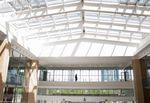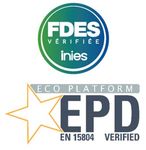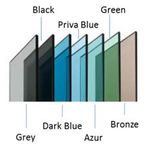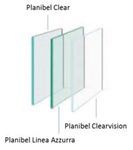AGC GLASS EUROPE ENVIRONMENTAL AND HEALTH PRODUCT DECLARATION - | AGC Yourglass
←
→
Page content transcription
If your browser does not render page correctly, please read the page content below
ENVIRONMENTAL PRODUCT DECLARATION
in accordance with ISO 14025 and EN 15804+A1
AGC GLASS EUROPE
ENVIRONMENTAL AND HEALTH PRODUCT DECLARATION
Planibel
(Clear, Clearlite, Clearvision, Linea Azzurra, Coloured)
In accordance with ISO 14025, EN 15804+A1 and its French national complement NF EN15804/CN
28 May 2018ENVIRONMENTAL PRODUCT DECLARATION
in accordance with ISO 14025 and EN 15804+A1
1. Warning
Information from this declaration are provided under AGC Glass Europe responsibility according to the
standards EN 15804+A1 and the French national complement NF EN15804/CN.
Any total or partial use of the information provided in this document shall at least be accompanied by an
explicit reference to this EPD as well as its issuer. The latter can provide the original document upon request.
EN 15804+A1 from CEN has been used as Product Category Rules (PCR).
2. Reading guide
Environmental impacts results, resource use indicators as well as waste and output flows are presented in
scientific writing with three significant digits.
All positive values (plus sign) refer to environmental impacts, while negative values (minus sign) reflect
environmental benefits. This approach applies to all modules, including module D. Hence, if module D is
higher than zero, an additional impact must be added to other life cycle stages.
3. Comparability of EPD for construction products
Environmental product declarations may not be comparable if they do not comply with EN15804+A1.
Chapter 5.3 Comparability of EPD construction products from EN15804+A1 norm defines the required
conditions under which the construction products can be compared, on the basis of the information provided
by the EPD:
A comparison of the environmental performance of construction products, based on their EPDs, shall be
based on the use of the products and their impacts on the building, and shall account for the entire life cycle
of the product (i.e. include all information modules).ENVIRONMENTAL PRODUCT DECLARATION
in accordance with ISO 14025 and EN 15804+A1
4. General information
AGC Glass Europe
Name and address of Avenue Jean Monnet 4
the manufacturer B‐1348 Louvain‐la‐Neuve
sustainability@eu.agc.com
This EPD is representative for float glass sold by AGC Glass Europe / AGC
Interpane in France. AGC Glass Europe operates 10 production sites in Europe
Production sites
providing float glass to French and European market. Results from this EPD
reflects data collected from all these sites.
☐ Cradle to factory gate
☒ Cradle to grave
Type of EPD
☐ Collective
☒ Individual
Verifier name Thomas Peverelli (EVEA)
FDES INIES
www.inies.fr
Responsable du programme Gestionnaire du programme
Program operator Conseil de Surveillance Inies Base (CSIB) Association Française de Normalisation
11 rue Francis de Pressensé (AFNOR)
93571 Saint‐Denis la Plaine Cedex Département Construction et Cycle de
l’Eau (DCE)
11 rue Francis de Pressensé
93571 Saint‐Denis la Plaine Cedex
Publication date May 2018
Expiration date May 2023
Planibel Clear
Planibel Clearlite
Planibel Clearvision
Commercial references
Planibel Coloured
Planibel Linea Azzurra (only covered through extrapolation rules since not
available in the 4mm reference dimensions)
AGC Glass Europe 3 / 165. Functional unit and product description
5.1. Description of the functional unit
The functional unit is to ensure 1m² of facade glazing with (extra) clear glass over 30 years.
Note: The reference service life of the product is set to 30 years. This period does not reflect real product
lifetime, which is generally defined by building refurbishment. This period reflect a standard duration of use
considered in glazing EPDs.
RSL does not refer to product guarantee neither.
5.2. Product description
AGC Planibel range covered by this EPD is a float glass of 4 mm (reference thickness) clear, extra‐clear or
tinted:
Planibel Clear
Planibel Clearlite
Planibel Clearvision
Planibel Linea Azzurra, only though extrapolation rules since not available in 4mm thickness
Planibel Coloured
Other structures are considered in the underlying calculations for 2, 3, 5, 6, 8, 10, 12, 15, 19, 22, 25 mm and
including thermal toughening and heat soak treatment of the aforementioned glass thicknesses.
This product is defined by the standard EN 572‐9:2004 “Glass in building. Basic soda lime silicate products.
Evaluation of conformity”.
Planibel range of products also complies with the following standards:
EN 572‐1 – Glass in building. Basic soda‐lime silicate glass products. Definitions and general physical
and mechanical properties
EN 572‐2 – Glass in building. Basic soda lime silicate glass products. Float glass.
All Planibel products are CE marked in accordance with EN 572‐9 and are produced in ISO 9001 and
ISO 14001 certified factories.
More information available on www.yourglass.com.
AGC Glass Europe 4 / 165.3. Description of the product usage
Float glass is meant to be used for building facades and construction projects. It can also be used in a wide
range of other construction applications. In that case, glass can be delivered with technical properties fitting
with specific use requirements.
Table 1 : Product characteristics
Product specification Symbol Value
Thermal transmission (according to EN 673) Ug (W/m².K) 5.7
Light Transmission (EN 410) Tv (%) max 92
Light Reflection (EN 410) ρv (%) 8
Solar factor g (%) max 91
Direct airborne sound insulation (EN 12578) Rw (C;Ctr) (dB) 30 (‐2;‐4)
Reaction to fire (EN 13501‐1) A1
Resistance to fire (EN 13501‐2) No performance declared
Burglar resistance (EN 356) No performance declared
Bullet resistance (EN 1063) No performance declared
Resistance to explosion (EN 13541) No performance declared
Float glass has no specific properties as regards fire resistance or impacts (break‐in, fire arms, explosion). No
performance is declared for these aspects.
5.4. Other technical features not included in the functional unit
Not applicable.
5.5. Description of the product main components and/or material
Despite differences as regards properties and functionality from one product range to the other, float glass
always has a similar baseline composition. They can be defined as products resulting from the mixture of
three main raw material categories: forming materials, intermediate materials, colouring agents.
Silica sand and glass cullet work as vitrifying material, sodium carbonate is used to decrease silica melting
point, limestone is a stabilizer that gives glass its chemical resistance. Others agents are used to improve
mechanical characteristics and resistance to external conditions as well as for its colour.
AGC Glass Europe 5 / 16Table 2 : Generic float glass composition
Product composition average %
Forming materials 62%
* Silica sand
* External cullet
Intermediate materials 37%
* Sodium carbonate
* Dolomite
* Limestone
* Feldspar
* Sodium sulphate
Colouring agents 1%
* Iron oxides and other metallic oxides
Product mass 10 kg / m2
Packaging 100g
* Metallic stillage
* Interleaving powder
Primary data used as input and output as well as transport data have been collected among AGC Glass
Europe 10 float glass production sites.
5.6. Substances from REACH candidate list
Planibel float glass does not contain any substance from REACH candidate list according to REACH regulation
(more than 0.1%)
5.7. Reference service life description
The reference service life (RSL) of float glass is 30 years.
AGC Glass Europe 6 / 16Table 3 : Reference conditions of product use justifying RSL
Parameter Value
Reference service life 30 years
Declared product properties (when leaving the production site) These properties are defined in float glass definition standard
and finishing EN 572‐9:2004 Glass in building. Basic soda lime silicate
products. Evaluation of conformity
Theoretical application parameters (if imposed by the
producer), including references to the appropriate use practices
Alleged quality of the construction work, when the installation is
made in accordance with the manufacturer’s instructions
These information are detailed in the standard
NF DTU 39:2006 Building works – Glazing and Mirror Glass
Exterior environment (for exterior applications), e.g. weather
Works, which defines the specifications for the implementation
resistance, pollutants, UV and wind exposure, building
of glazing and installation of glazing products (new construction,
orientation, shade, temperature
renovation, refurbishment, maintenance) performed on site in
all types of buildings.
Interior environment (for interior applications), e.g.
temperature, humidity, chemicals exposure
Use conditions, e.g. usage frequency, mechanical exposure
Maintenance, e.g. required frequency, type and quality and
replacement of replaceable components
6. Life cycle stages
This EPD is a cradle to grave study including module D, benefits beyond the system boundaries.
Life cycle stages regarding product installation (A5) and product use (B1‐B7) are modelled based on Glass in
building product category rules prEN17074:2017.
6.1. Production stage, modules A1‐A3
Module A1‐A3 covers the production and transport of raw materials, float glass production sites
consumptions and emissions as well as impacts from energy use and waste treatment.
Float glass production process involves the following steps:
‐ Batch preparation
‐ Raw materials melting within the glass furnace. Raw materials are heated up to 1600°C in order to
melt them and ensure the required chemical reaction (decarbonation).
‐ Glass is then poured on a molten tin bath called “float”, giving to the glass its flat shape. Tin bath is
used for its high density (6500 kg/m³), which is much higher than the one of glass (2500kg/m³).
‐ The glass ribbon is then cooled down in a controlled atmosphere and at a controlled temperature to
ensure that the outgoing glass has the required properties. It is then cut in large panes of 3.21m by
6m called PLF (Plateau Largeur de Fabrication).
AGC Glass Europe 7 / 16Batch
feeder
Float glass
6.2. Construction process stage, modules A4‐A5
Transport distance to construction sites (module A4) considers the weighted average distance between the
10 AGC floats and Paris.
As regards installation on site (module A5), no ancillary materials is considered for the glass to be installed in
accordance with prEN17074:2017.
No breakage during transport and installation has been considered, following prEN17074:2017.
1. Transport to the construction site
Transport to construction site considers an average distance of 1150 km. This value reflects the weighted
average distance between the 10 AGC floats and Paris. Float glass is transported by road in diesel trucks of
24.7 tonnes net load.
Table 4 : Transport to construction site
Parameter Value Unit
Tonne | Diesel truck ‐ EURO 5 –
Vehicle description 25
cargo, 40 t gross payload
Distance to construction site 1150 km
Utilisation rate (including empty return) 50% %
Volumetric mass 2500 kg/m3
Coefficient of utilisation of the volume capacity 0.6
Average load and utilisation rate correspond to the use of “inloaders” trucks dedicated to glass
transportation. These trucks are loaded at full capacity when leaving factories but have no possibility to
transport other goods than glass when traveling back. The utilisation rate of 50% reflects thus a 100%
utilisation for the outbound journey and an utilisation rate of 0% for the inbound journey.
2. Installation on site
No ancillary materials is considered for the glass to be installed in accordance with prEN17074:2017.
AGC Glass Europe 8 / 16Packaging end of life is accounted in module A3 as detailed in prEN17074:2017 product category rule.
6.3. Use stage, modules B1‐B7
1. Description
The only module from the use stage considered is B2 “maintenance”. This stage corresponds to glass
cleaning with water and detergent.
Repair (B3), replacement (B4) and refurbishment (B5) are not considered. Under normal conditions of use,
float glass does not need any of these operations.
Finally, float glass does not emit any substances neither to the air nor to water during its use (B1).
2. Maintenance parameters
Following prEN17074:2017, the average annual water consumption is 0.2 litres per square meter of glass
(i.e. 6 litres/m² over the whole life cycle) and an annual consumption of detergents of 10 g/m² (300 g/m²
over the whole life cycle). The majority of this water (75%) is considered as discharged to sewer grid and
further treated in a wastewater treatment plant. The remaining 25% is considered as evaporated.
Table 5 : Glass maintenance
Parameter (whole life cycle) Value Unit
Water consumption for maintenance 6 litres
Detergent consumption 300 g
Waste water discharge to WWTP 4.5 litres
6.4. End of life stage, modules C1‐C4
No mechanical operation is considered as regards dismantling and demolition (module C1).
End of life includes:
- C2: transport to waste treatment site ;
- C3: waste treatment ;
- C4: landfilling of demolition wastes.
End of life scenario is based on worst case scenario, considering that 100% of the float glass is sent to landfill
for inert material in the end of life.
AGC Glass Europe 9 / 16Table 6 : End of life scenarios
Parameter Value Unit
Waste glass sent to landfill 100 %
Transport to landfill (truck) 30 km
Waste glass recycled 0 %
All glass wastes are transported by diesel truck with a net payload of 22 tonnes.
6.5. Benefits and loads beyond the system boundaries (module D)
As the end of life scenario is a worst case (100% landfill), module D consist in additional impacts
corresponding to the benefits from the use of secondary materials at production stage (A1‐A3).
As no float glass is sent to recycling in the end of life, the benefits accounted in A1‐A3 is offset by additional
impacts of the same value accounted in module D. In the end of life formula, these impacts are referred as
IV ‐ IS.
This additional impact is calculated as the sum of:
- An additional production of virgin raw materials (silica sand, sodium carbonate, dolomite
etc.).
- An additional energy consumption due to the substitution of cullet by virgin raw materials.
Cullet requires 25% less energy than virgin raw materials to melt. The higher energy
consumption from virgin raw materials also means higher CO2 emissions from fossil fuel
combustion.
- An additional CO2 emissions due to decarbonation of virgin raw materials used instead of
cullet. Indeed, cullet does not go to decarbonation as opposed to virgin raw materials.
AGC Glass Europe 10 / 16ENVIRONMENTAL PRODUCT DECLARATION
in accordance with ISO 14025 and EN 15804+A1
7. Information regarding life cycle assessment calculation
NF EN 15804+A1
PCR used NF EN 15804/CN
prEN 17074 :2017
System boundaries Cradle to gate including module D
Allocations Mass allocation
Geographical representativeness: 10 AGC European float glass production sites.
Distribution in France.
Time representativeness: input/output primary data as well as transport data from
2016
GaBi 8.6.0.20 software and database service pack 35 have been used for secondary
data and calculation of the LCI and LCIA.
8. Life cycle assessment results
8.1. Description of the system boundary
Benefits
and loads
Construction
Product beyond
process Use stage End of life
stage the system
stage
boundarie
s
C3 Waste processing
C1 Deconstruction
B4 Refurbishment
B6 Use of energy
B2 Maintenance
B4 Replacement
B7 Use of water
A5 Installation
B3 Reparation
A4 Transport
C2 Transport
/demolition
Total A1‐A3
C4 Disposal
Production
B1 Usage
D
Module
X X X NR X NR NR NR NR NR NR X X X X
declared
X: included in the LCA NR: Not relevant for the product studied
8.2. Environmental impact indicators
The life cycle impact assessment methods recommend by EN 15804+A1 were used. The impact indicators are
presented in the following tables for the different AGC float glass thicknesses available.
AGC Glass Europe 11 / 16ENVIRONMENTAL PRODUCT DECLARATION
in accordance with ISO 14025 and EN 15804+A1
Environmental impacts of 4 mm float glass
Benefits
and loads
Production Construction
Use stage End of life stage beyond
stage process
system
boundaries
Environmental impacts
A1‐A3
of
Waste
B2 Maintenance
B4 Replacement
B7 Use of water
Deconstruction
Refurbishment
A5 Installation
B3 Reparation
A4 Transport
C2 Transport
/demolition
C4 Disposal
Production
processing
Use
B1 Usage
energy
Total
B6
B4
C1
C3
D
Global warming potential
1.16E+01 8.88E‐01 NR NR 6.87E‐03 NR NR NR NR NR NR 5.06E‐02 0 1.59E‐01 5.94E‐01
(kg CO2 eq./FU)
Ozone depletion
1.13E‐08 2.42E‐14 NR NR 2.69E‐09 NR NR NR NR NR NR 1.40E‐15 0 3.60E‐14 7.36E‐10
(kg CFC‐11 eq./FU)
Acidification of land and water
4.95E‐02 2.15E‐03 NR NR 2.32E‐04 NR NR NR NR NR NR 2.98E‐04 0 9.34E‐04 1.11E‐03
(kg SO2 eq./FU)
Eutrophication
7.36E‐03 5.22E‐04 NR NR 1.65E‐04 NR NR NR NR NR NR 7.53E‐05 0 1.28E‐04 2.12E‐04
(kg PO4 eq./FU)
Photochemical ozone creation
3.16E‐03 2.14E‐04 NR NR 9.54E‐05 NR NR NR NR NR NR 2.36E‐05 0 7.32E‐05 8.58E‐05
(kg C2H4 eq./FU)
Depletion of abiotic resources‐
1.27E‐05 6.61E‐08 NR NR 1.77E‐07 NR NR NR NR NR NR 3.82E‐09 0 2.19E‐08 6.18E‐08
elements (kg Sb eq./FU)
Depletion of abiotic resources‐fossil
1.52E+02 1.20E+01 NR NR 3.88E‐01 NR NR NR NR NR NR 6.96E‐01 0 2.06E+00 5.82E+00
fuels (MJ/FU)
AGC Glass Europe 12 / 16Benefits
and loads
Production Construction
Use stage End of life stage beyond
stage process
system
boundaries
Resource use
A1‐A3
of
Waste
B2 Maintenance
B4 Replacement
B7 Use of water
Deconstruction
Refurbishment
A5 Installation
B3 Reparation
A4 Transport
C2 Transport
/demolition
C4 Disposal
Production
processing
Use
B1 Usage
energy
Total
B4
B6
C1
C3
D
Renewable primary energy as energy
5.63E+00 6.66E‐01 NR NR 1.33E+00 NR NR NR NR NR NR 3.85E‐02 0 2.64E‐01 1.15E‐01
carrier (MJ/FU)
Renewable primary energy resources
0 0 NR NR 0 NR NR NR NR NR NR 0 0 0 0
used as raw materials (MJ/FU)
Total use of renewable primary energy
5.63E+00 6.66E‐01 NR NR 1.33E+00 NR NR NR NR NR NR 3.85E‐02 0 2.64E‐01 1.15E‐01
resources (MJ/FU)
Non‐renewable primary energy
1.60E+02 1.21E+01 NR NR 6.18E‐01 NR NR NR NR NR NR 6.98E‐01 0 2.14E+00 5.93E+00
resources as energy carrier (MJ/FU)
Non‐renewable primary energy
resources used as raw materials 0 0 NR NR 0 NR NR NR NR NR NR 0 0 0 0
(MJ/FU)
Total use of non‐renewable primary
1.60E+02 1.21E+01 NR NR 6.18E‐01 NR NR NR NR NR NR 6.98E‐01 0 2.14E+00 5.93E+00
energy resources (MJ/FU)
Use of secondary material (kg/FU) 8.90E‐01 0 NR NR 0 NR NR NR NR NR NR 0 0 0 0
Use of renewable secondary fuels
2.01E‐20 6.52E‐29 NR NR 2.63E‐24 NR NR NR NR NR NR 3.77E‐30 0 3.24E‐23 1.87E‐21
(MJ/FU)
Use of non‐renewable secondary fuels
2.36E‐19 9.90E‐28 NR NR 3.09E‐23 NR NR NR NR NR NR 5.72E‐29 0 3.80E‐22 2.20E‐20
(MJ/FU)
Use of net fresh water (m³/FU) 2.23E‐02 1.23E‐03 NR NR 8.52E‐03 NR NR NR NR NR NR 7.10E‐05 0 4.08E‐04 1.33E‐03
AGC Glass Europe 13 / 16Benefits
and loads
Production Construction
Use stage End of life stage beyond
stage process
system
boundaries
Wastes
A1‐A3
Waste
of
B2 Maintenance
B4 Replacement
B7 Use of water
Deconstruction
Refurbishment
A5 Installation
B3 Reparation
A4 Transport
C2 Transport
/demolition
C4 Disposal
Production
processing
Use
B1 Usage
energy
Total
B4
B6
C1
C3
D
Hazardous waste disposed
3.51E‐07 6.99E‐07 NR NR 1.74E‐10 NR NR NR NR NR NR 4.04E‐08 0 3.67E‐08 1.64E‐08
(kg/FU)
Non‐hazardous waste disposed
2.37E‐01 1.01E‐03 NR NR 7.68E‐03 NR NR NR NR NR NR 5.85E‐05 0 1.00E+01 1.93E‐02
(kg/FU)
Radioactive waste disposed
3.26E‐03 1.65E‐05 NR NR 3.18E‐06 NR NR NR NR NR NR 9.56E‐07 0 3.09E‐05 2.78E‐05
(kg/FU)
Benefits
and loads
Production Construction
Use stage End of life stage beyond
stage process
system
boundaries
Output flows
of
A1‐A3
Waste
B2 Maintenance
B4 Replacement
B7 Use of water
Deconstruction
Refurbishment
A5 Installation
B3 Reparation
A4 Transport
C2 Transport
/demolition
C4 Disposal
Production
processing
Use
B1 Usage
energy
Total
B4
B6
C1
C3
D
Components for re‐use (kg/FU) 0 0 NR NR 0 NR NR NR NR NR NR 0 0 0 0
Materials for recycling (kg/FU) 1.93E‐01 0 NR NR 0 NR NR NR NR NR NR 0 0 0 0
Materials for energy recovery (kg/FU) 0 0 NR NR 0 NR NR NR NR NR NR 0 0 0 0
Exported electrical energy (MJ/FU) 0 0 NR NR 0 NR NR NR NR NR NR 0 0 0 0
Exported thermal energy (MJ/FU) 0 0 NR NR 0 NR NR NR NR NR NR 0 0 0 0
AGC Glass Europe 14 / 16ENVIRONMENTAL PRODUCT DECLARATION
in accordance with ISO 14025 and EN 15804+A1
9. Additional information
9.1. Release of hazardous substances into indoor air, soil and water during the use stage
9.1.1. Indoor air
- VOC and formaldehyde emissions
Not applicable
- Reaction to fungal and bacterial growth
Not tested. Glass is a mineral inert material. It is not by itself a medium for micro‐organisms growth.
- Natural radioactive emissions from construction products
Not tested.
- Emission of particulates and fibres emissions
Not tested.
9.1.2. Water and soil
Not tested. The product is not in contact with water intended for human consumption.
9.2. Product contribution to indoor wellbeing
9.2.1. Product characteristics regarding hygrothermal comfort
The relevant technical characteristics are given for a 4 mm float glass:
Thermal coefficient Ug = 5,8 W/(m².K), according to EN 673 ;
Direct energy transmission : 84 % ;
Energy reflection : 8 % ;
Solar factor: 86 %.
Source: CE marking
9.2.2. Product characteristics regarding acoustics
A 4 mm float glass has a direct airborne sound insulation Rw (C; Ctr) = 30 (‐2 ; ‐4) dB.
This characteristic can be improved by using thicker or asymmetric glass panes. For example, a 12 mm float
glass has a direct airborne sound insulation Rw (C; Ctr) = 35 (‐2 ; ‐3) dB.
Source: CE marking
AGC Glass Europe Page 15 of 169.2.3. Product characteristics regarding visual comfort
The relevant technical characteristics are given for a 4 mm float glass:
Light transmission: 90 % ;
Light reflection: 8 % ;
Direct energy transmission : 84 % ;
Energy reflection : 8 % ;
Solar factor: 86 %.
Source: CE marking
9.2.4. Product characteristics as regarding odours
Not tested. Glass is a mineral inert material, not able to release any odour during its use.
9.3. Extrapolation rules
Indicators from the EPD are proportional to product mass and thus to glass thickness. In case of similar
product with other thicknesses than those available in the EPD, results can be calculated by considering an
extrapolation based on mass or thickness. Both approach provides similar results.
More information available on www.yourglass.com
And in the « Sustainability » section of our environmental website www.agc‐glass.eu/en/sustainability
AGC Glass Europe 16 / 16You can also read





















































